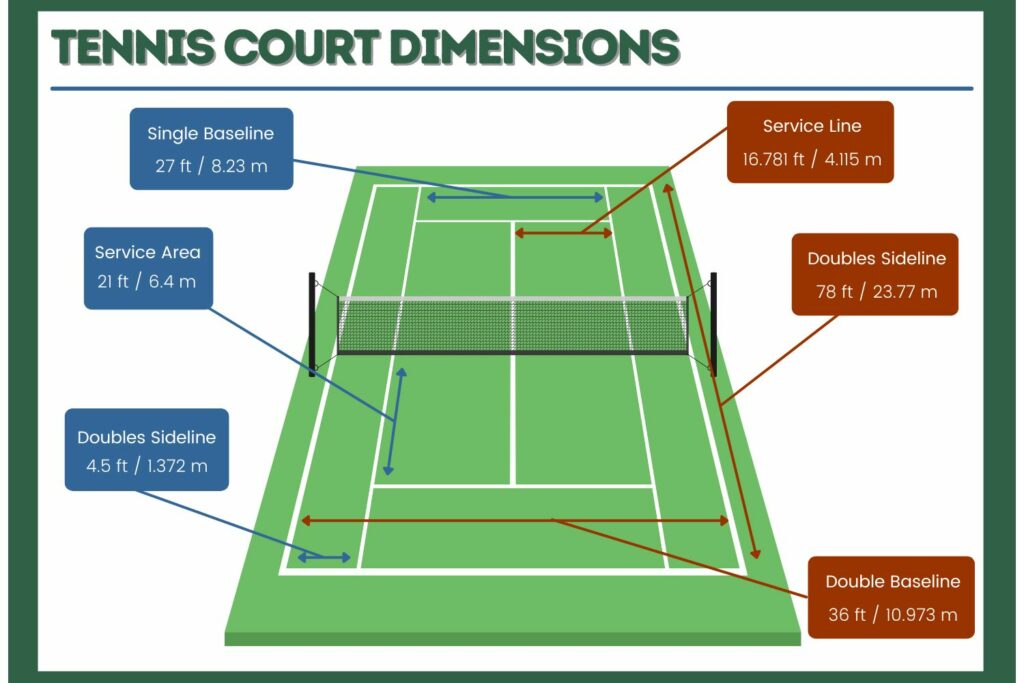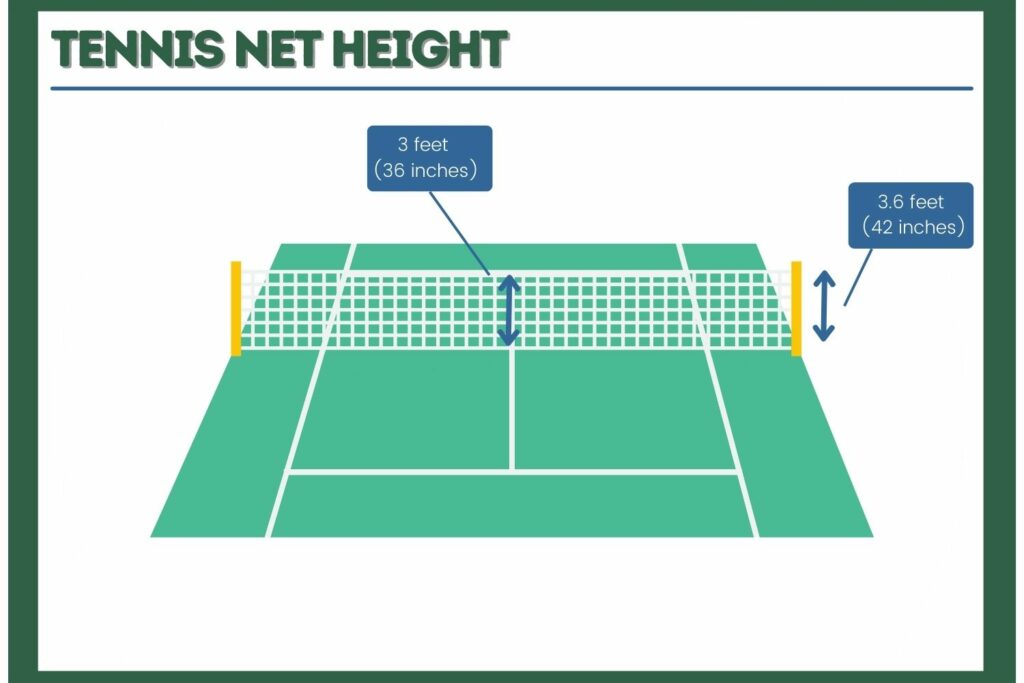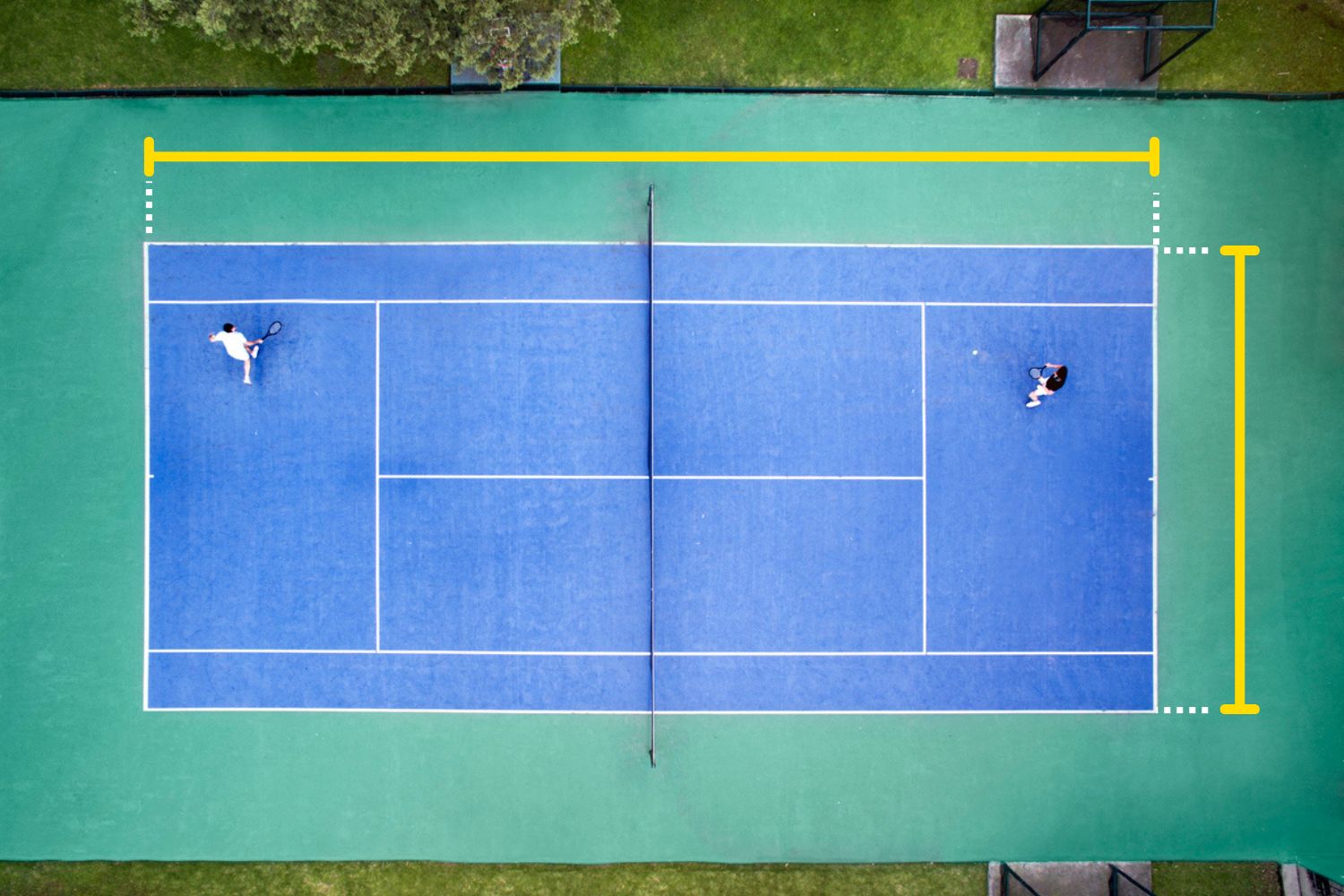If you are a beginner in tennis, it’s worth taking your time and learning the basics about the tennis court dimensions and layout. This is important information because it will help you be more comfortable and confident during the training or matches. All angles are important in tennis; you can not master the game’s techniques properly if you aren’t familiar with the court. This knowledge will also help you develop your style and strategy and hit longer, more powerful shots while remaining in better control of the game’s outcome.
Across the world, tennis courts have the same standard sizes and dimensions, so learning about this stuff isn’t complicated at all. In this guide, we will explain everything you need to know so that you already feel like a pro the next time you hit the court.
Tennis Court Dimensions
Tennis court dimensions are 78 feet (23.77 m) long and 36 feet (10.9mm) wide; the total tennis court size is 2.808 square feet (260 sq. m). The court’s full size is only used for doubles players, who are allowed to go all the way to the outer double sidelines.

Singles Tennis Court Dimensions
Single tennis court dimensions are 78 feet (23.77 m) long and 27 feet (8.23 m) wide, with a total size of 2.106 square feet. (195.6 sq. m). ITF guidelines regulate these dimensions to allow single players to use a narrow width for a fair game.
Indoor Tennis Court Dimensions
Indoor tennis courts are similar to standard tennis court sizes, as regulated by ITF guidelines. However, depending on the space available, the indoor court size has the full dimensions; 78 feet x 36 feet.
The minimum overhead space should be 40 feet from the net’s height for protection measurements.
ITF allows only three structural types of tennis courts, which includes Air Supported structure, a Rigid Frame structure, and a Fabric Frame structure. The indoor courts must include other facilities, such as air conditioning, ventilation, lighting system, proper ceiling system, etc.
The rules for single and double players apply the same. Indoor courts are protected from weather elements, and as a result, they have less damage overall.
Overall Court Playing Surface Dimensions
Every tennis court has marked lines, a play area, and additional run-off elements. Not only are they important in the dimensions of a tennis court, but they are part of tennis terminology as well, so you need to learn these if you are serious about the game or want to build a tennis court.
Here are the lines of the tennis court:
- Baseline is 36 feet long for doubles and 27 feet for singles. This line is parallel to the net, where the player serves and hits groundstrokes. The baseline is the furthest boundary line, as it is at the back of the court. Suppose the ball lands beyond the baseline are out of bounds. The additional space called “double alleys” is used in double matches to give enough space for two people to play.
- Center mark is 4 inches long, and it refers to the point in the middle of the baseline, which divides it in half. It runs perpendicular to the net and is an indicator for servings; the player should not pass the center mark when hitting the serve, regardless if it is in deuce or ad court. This is also the reference point; if your coach tells you to return to the center after hitting groundstrokes, you should return to the center mark.
- The service line is 27 feet wide and is used as a boundary mark for service boxes, and it runs only to the single sidelines. It is parallel to the net and stands as a middle point between the net and the baseline.
- Center service line is 42 feet long; 21 feet on each court’s side. The center service line is used to create two service boxes of equal sizes; it runs perpendicular to the net and extends to meet the service line.
- Single sidelines are 39 feet long and are used to define the court’s boundaries for single players matches. This line always runs perpendicular to the net.
- The double sidelines are 39 feet long. Double sidelines also run perpendicular to the net and are only a few feet outside of the single sidelines. They define the court’s boundaries for the double players’ matches.
Now that you know all about the marked line of a tennis court, let’s get through the areas of the court. Here is what you should know.
- Left and right service box: The center service line creates two serving boxes on the right and left sides of the court. Both have equal sizes; 21 feet x 13.5 feet.
- Double alleys: Has a dimension of 39 feet x 13.5 feet. It referees to the space between single and double sidelines.
- “No man’s land”: is the largest box on the court, with 18 feet x 27 feet. It falls between the baseline and sideline and is the area your coach will insist you avoid standing on. It’s called “no man’s land” because the net is too far to hit volleys and too close to hit groundstrokes.
The additional elements of the court are as follows:
- Net is 42 feet wide and 3.5 feet high. It spits the courts on two sides, right in the middle. Usually, tennis nets are made of mesh materials, which don’t allow the ball to go through. A smart thing you can do is always bring a measuring tape to the court, just to make sure that the tennis net is at the right height.
- Net posts are only 3.5 feet tall and 6 inches wide. Usually, they fall in the middle of the court, just three feet outside the double sidelines. For courts with a single net, the net post falls three feet away from the singles sidelines for courts with a single net.
- Single sticks are 3.5 inches tall and 3 inches wide. These are used for single-player games on courts with a double-net installation. Single sticks are 3 feet away from every single sideline and are more common in professional matches.

Tennis Court Dimensions with Fence
The fence around a tennis court should be at least 21 feet away from the baseline in both directions. The distance between the service line and the baseline adds another 18 feet distance, meaning the fence is 39 feet away from each side of the court.
The usual fence dimensions are 120 feet long and 60 feet wide; always built with the courts centered in the middle; the height is 10 feet tall. Most people widely accept these measurements; however, these aren’t regulated by the ITF guidelines.
Wrapping Up
This is all you need to know about the tennis court’s dimensions. Easy, right? Learning this
stuff will make you feel confident and fall even more in love with the game. You can use this knowledge if you ever decide to build a backyard tennis court too. Make sure to share this guide with another beginner friend who might need some help too, and take a look at our other articles to learn more about tennis.

